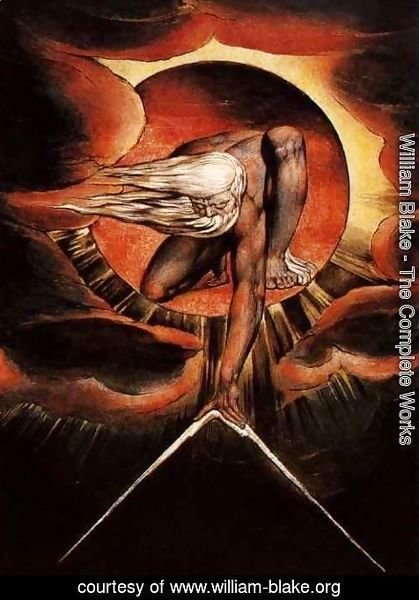Sheila Bautz
A Lifetime of Visions… Poetic Flow… Artistic Flare… Inventions… William Blake was a prolific Poetic Genius born in 1757 during the Industrial Revolution in Britain. He studied art as a child at the academy of Henry Pars followed by a seven year apprenticeship under James Basire. Shortly after his apprenticeship with Basire, in 1779, Blake began to experiment with improving the printing process and its techniques. (Bentley, 1981).
Visions of Relief in Etching
In 1787, after the death of William Blake’s younger brother, Robert, Robert appeared to Blake in a vision and instructed him on how to create a revolutionary printing apparatus. A highly original concept, the resulting invention became known as relief etching. Blake’s relief etching apparatus created a very modest revenue for him as he commissioned printing the selected works of others in addition to his own. For instance, some commissioned works included printing large visual works of art in colour. As a result, Blake’s printing press not only revolutionized the printing process, but it also allowed Blake to maintain all control over the creation and production process of publishing books and images – from start to finish. (Barker, 2004).
The end product of the published ethereal works in bookform became known as illuminated books. The illuminated books printed by Blake ranged in topics from prophetic and biblical works to children books while addressing social and moral issues during this time period. Such social issues included child exploitation and labour, racial inequality, tyranny and religious hypocrisy. (Barker, 2004).
How Relief Etching Works:
Relief etching entailed Blake etching impressions of artwork and text onto a copper plate using a technique called mirror writing. (Phillips, 2018). In its primitive form, mirror writing is simply encoding a message by writing it backwards. Left handed individuals possess this distinct ability that often had a mystical association with this rare talent – and to which Blake excelled at and demonstrated through his creation of the copper plates. (Schott, 2007).
Meticulous in his creations, William Blake regularly printed his, and others, writing and art in vivid colours. As such, he developed a unique method of colour-printing using several different colours at once with a careful application technique to achieve the results he desired, which are pleasing to the eye and senses. (Phillips, 2018).
Blake’s techniques in ink application are an artform in themselves, involving the careful application of the ink onto leather covered daubers before applying the appropriate amount of dauber pressure to his etched copper plates. Due to the design of Blake’s copper plates, the raised surfaces allowed him to use very little pressure to the paper during the initial printing process, which resulted in his ability to print on the verso of the same sheet of paper without reapplying the ink. The pressure applied during the printing process resulted by turning a large spoked wheel to press the inked plates to the paper. As such, additional impressions were printed with the residue ink left on the copper plate, which avoided ink reapplication to print every single page. To print another page of the same copper plate, Blake simply increased the pressure for the succeeding impressions of ink to paper by adding padding, usually a thin wool blanket, before sending the copper plate through the rollers again without having to reapply ink to the copper plates. Once the sheets of printed material were bound together, the books’ printed impressions faced each other in a conventional book form, saving time. (Phillips, 2018).
Credit: The British Library.
Due to Blake’s meticulous application of the ink to the etched copper plates, each sheet he printed is uniquely distinct with subtle differences in the tones and textures of the printed material. In this sense, each print is an original in its own right even though it is a duplicate produced from the copper etching. (Phillip, 2018).
For more information on William Blake’s printing process, please click here: http://www.williamblakeprints.co.uk/how-the-prints-are-made/
Works Cited:
Barker, Elizabeth E. 2004. “William Blake (1757 – 1827)”. Heilbrunn Timeline of Art History. New York: The Metropolitan Museum of Art. Website Accessed 19 January 2019. https://www.metmuseum.org/toah/hd/blke/hd_blke.htm
Bentley, G.E. Jr. 1981. “William Blake’s techniques of Engraving and Printing”. Studies in Bibliography. Vol. 34 (1981), pp. 241-253.
The British Library. 2014. “William Blake’s Printing Process”. Filmed at Morley College, London. YouTube. Date Accessed January 17, 2019. https://youtu.be/96LUAaaPqRc
Phillips, Michael. 2018. “Making the Plates”, “Inks and Papers”, “The Printing Process”, “William Blake’s Printing Process”. William Blake Prints. Website Accessed 19 January 2019. http://www.williamblakeprints.co.uk/how-the-prints-are-made/
Schott, GD. 2007. “Mirror writing: neurological reflections on an unusual phenomenon”. J Neurol Neurosurg Psychiatry. 2007 Jan; 78(1): 5–13. Website Accessed 19 January 2019. https://www.ncbi.nlm.nih.gov/pmc/articles/PMC2117809/
